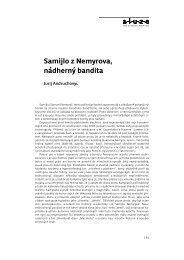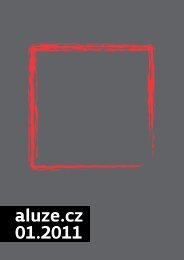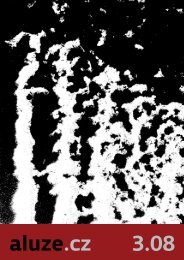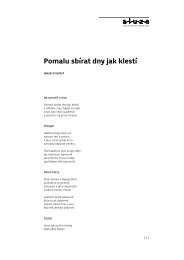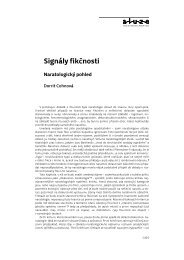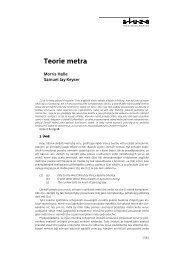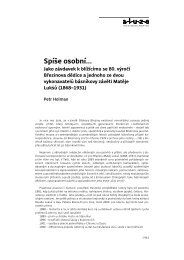StáhnÄte si celé ÄÃslo ve formátu PDF - Aluze
StáhnÄte si celé ÄÃslo ve formátu PDF - Aluze
StáhnÄte si celé ÄÃslo ve formátu PDF - Aluze
You also want an ePaper? Increase the reach of your titles
YUMPU automatically turns print PDFs into web optimized ePapers that Google loves.
[studie]<br />
ALUZE 2/2009 – Revue pro literaturu, filozofii a jiné<br />
Seriously“, History of Science 29, 1991, s. 377–392; srov. Edward Grant, A History of Natural Philosophy.<br />
From the Ancient World to the Nineteenth Century, Cambridge, Cambridge Uni<strong>ve</strong>r<strong>si</strong>ty<br />
Press 2007, s. 274–302.<br />
16 Joseph Priestley, History and Present State of Electricity, Pater-noster Row, London, s. xi, xx.<br />
17 Alistair C. Crombie, The History of Science From Augustine to Galileo, Do<strong>ve</strong>r, New York 1995,<br />
sv. I, s. 131–139<br />
18 Otto Mazal, Geschichte der abendländischen Wissenschaft des Mittelalters, 2 sv., Graz, Akademische<br />
Druck- u. Verlagsanstalt 2006, sv. II, s. 167–285.<br />
19 Alistair C. Crombie, The History of Science From Augustine to Galileo, sv. I, s. 89–110.<br />
20 Robert S. Westman, „The Astronomer’s Role in the Sixteenth Century: A Preliminary Study“,<br />
History of Science 18, 1980, s. 105–147.<br />
21 Viz Hans Blumenberg, Die Legitimität der Neuzeit. Erneuerte Ausgabe, Frankfurt a. M.,<br />
Surhkamp 1996, s. 263–528.<br />
22 Isaac Newton, Philosophiae naturalis principia mathematica, Innys, Londini 1726 3 , s. 530. Obdobně<br />
Isaac Newton, Opticks, Innys, London 1721 3 , s. 344.<br />
23 Robert Hooke, Micrographia: Or Some Phy<strong>si</strong>ological Descriptions of Minute Bodies made by<br />
Magnifying Glasses, Martin & Allestry, London 1665, fol. vi–xiii. Srov. Lutz Dannenberg, Säkulari<strong>si</strong>erung<br />
in den Wissenschaften seit der frühen Neuzeit. Bd. 3. Die Anatomie des Text-Körpers<br />
und Natur-Körpers. Das Lesen im liber naturalis und supernaturalis, De Gruyter, Berlin – New<br />
York 2003, s. 266–272.<br />
24 George Sarton, Ancient Science Through the Golden Age of Greece, s. 247; Samuel Sambursky,<br />
Das phy<strong>si</strong>kalische Weltbild der Antike, Zürich – Stuttgart, Artemis Verlag 1965, s. 39; Benjamin<br />
Farrington, Věda <strong>ve</strong> starém Řecku a její význam pro nás [1944], 2 sv., přel. O. Klein, P. Kovály,<br />
Praha, Rovnost 1950–1951, sv. I, s. 59–62.<br />
25 R. W. Serjeantson, „Proof and Persua<strong>si</strong>on“, in: Lorraine Daston – Katherine Park (eds.), The<br />
Cambridge History of Science. Vol. 3. Early Modern Science, Cambridge, Cambridge Uni<strong>ve</strong>r<strong>si</strong>ty<br />
Press 2006, sv. III, s. 134–176, zde s. 159–162; Peter Dear, „Totius in Verba: Rhetoric and Authority<br />
in the Early Royal Society“, I<strong>si</strong>s 76, 1985, s. 144–161.<br />
26 Geofyzik Robert Newton vydal přímo knihu s náz<strong>ve</strong>m The Crime of Claudius Ptolemy (1977).<br />
Stručný přehled Ptolemiových „zločinů“ uvádí Hugh Thurston v článku „Greek Mathematical Astronomy<br />
Recon<strong>si</strong>dered“, I<strong>si</strong>s 93, 2002, s. 58–69. Z reakcí historiků astronomie lze uvést například<br />
práce Owena Gingeriche; viz Owen Gingerich, „The Trouble with Ptolemy“, I<strong>si</strong>s 93, 2002, s. 70–74;<br />
Owen Gingerich, „Was Ptolemy a Fraud“ in: Owen Gingerich, The Eye of Hea<strong>ve</strong>n. Ptolemy,<br />
Copernicus, Kepler, New York, AIP Press 1993, s. 55–80.<br />
27 V tomto bodě vycházím z Helge Kragh, Introduction to the Historiography of Science,<br />
Cambridge, Cambridge Uni<strong>ve</strong>r<strong>si</strong>ty Press 1987, s. 95–97.<br />
28 O odlišnostech v pojetí síly u u<strong>ve</strong>dených vědců pojednává Francois De Gandt, Force and Geometry<br />
in Newton’s Principia, Princeton, Princeton Uni<strong>ve</strong>r<strong>si</strong>ty Press 1995, s. 58–158. Srov. též poznámky<br />
známého newtonovského badatele Richarda Westfalla ke knize indického fyzika Subrahmanyan<br />
Chandrasekhara Newton’s Principia For the Common Reader (Oxford, Oxford Uni<strong>ve</strong>r<strong>si</strong>ty<br />
Press 1995), která převádí obtížný text Newtonových Principií do jazyka moderní fyziky; Richard<br />
S. Westfall, „Technical Newton“, I<strong>si</strong>s 87, 1996, s. 701–706.<br />
29 Přehled diskuze podává například Zev Bechler, Newton‘s Phy<strong>si</strong>cs and the Conceptual Structure<br />
of the Scientific Revolution, Dordrecht – London – Boston, Kluwer 1991, s. 105–122.<br />
30 Mario Biagioli, Galileo, the Courtier. The Practice of Science in the Culture of Absolutism, Chicago<br />
– London, Uni<strong>ve</strong>r<strong>si</strong>ty of Chicago Press 1993, s. 66–82.<br />
31 Alistair C. Crombie, The History of Science From Augustine to Galileo, sv. I., s. 140.<br />
32 Leo Elders, Filosofie přírody u sv. Tomáše Akvinského, přel. A. Cejnarová, Praha, OIKOYMENH<br />
2003, s. 131–151.<br />
33 Paola Zambelli, The Speculum Astronomie and Its Enigma. Astrology, Theology, and Science<br />
in Albertus Magnus and his Contemporaries, Dordrecht – Boston – London, Kluwer 1992, s. 75.<br />
34 V anglosaské historiografii vědy se tento typ anachronismu označuje ironicky výrazem „be<br />
wise after the e<strong>ve</strong>nt“; viz např. Joseph Agas<strong>si</strong>, „Towards an Historiography of Science“, History<br />
and Theory 2, 1963, Beiheft 2, s. 1–116, s. 51.<br />
35 Alexandre Koyré, Od uzavřeného světa k nekonečnému <strong>ve</strong>smíru, přel. P. Horák, Praha, Vyšehrad<br />
2004, s. 36.<br />
36 Viz např. Robert M. Youngson, Vědecké omyly, bludy a podvrhy, přel. V. Schreiber, Praha, H &<br />
H 2004, s. 87.<br />
37 James E. Force, „The Nature of Newton’s ‚Holy Alliance‘ between Science and Religion: From<br />
the Scientific Revolution to Newton (and Back Again)“, in: Margaret Osler (ed.), Rethinking the<br />
Scientific Revolution, , s. 247–270, zde s. 256.<br />
38 Charles Singer, A Short History of Science, Oxford Clarendon Press 1941, s. 200; podobně<br />
Eduard J. Dijksterhuis, The Mechanization of the World Picture, Oxford, Clarendon Press 1961,<br />
s. 304. Na tento rys keplerovského bádání upozorňují Peter Barker a Bernard R. Goldstein <strong>ve</strong> stu-<br />
[ 70 ]



